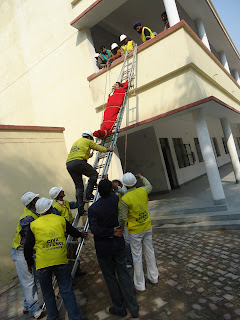The Civil Defence Act 1968 is applicable throughout the country, the organisation is only raised in such areas and zones which are tactically and strategically considered vulnerable from enemy attack points of view. At present, Civil Defence activities are restricted to 225 categorised towns spread over 35 States/Union Territories.
Civil Defence is primarily organised on voluntary basis except for a small nucleus of paid staff and establishment which is augmented during emergencies. The present target of Civil Defence volunteers is 12.49 lakhs, out of which 6.0 lakhs have already been raised and 4.8 lakhs have been trained. These volunteers are administered and trained by 68 Deputy Controllers, 17 Medical Officers and 503 Nos. of C. D. Instructors, which are full time paid posts.
SERVICES
Civil Defence Corps has the following 12 services in which volunteers are trained:-
- Headquarter Service
- Warden Service
- Communication Service
- Casualty Service
- Fire Fighting Service
- Rescue Service
- Welfare Service
- Salvage Service
- Corpse Disposal Service
- Depot & Transport Service
- Training Service
- Supply Service

To meet the early warning communication requirement against an enemy attack, a reliable and flexible network, both on telephone lines and radio/ wireless, have been planned and established in most of the categorised Civil Defence Towns. Against the target of 165 Nos., the Ministry has already provisioned full compliments of VHS Sets. In addition, 285 Nos. of latest generation state-of-art HF radio sets have already been provisioned against a target of 288 Nos. Remaining 13 HF sets are likely to be supplied during the ensuing financial year. Communication facilities, on telephone lines and radio, have also been planned and established in most of the Civil Defence towns for the purpose of command and control, co-ordination and liaison and also for mutual aid and co-operation. For this Fax Machines have already been authorised for all Civil Defence Control Centres in Categorised Towns in addition to normal line and radio. In addition, electronic solid state APP Equipment (EARP) and also Wireless Controlled ARP (W-ARP) for Simultaneous Broadcast Facilities (SBF) and Centres Control of Sirens (CCS) has also been developed in collaboration with ITI, Bangalore
Apart from carrying out training and demonstration of Civil Defence measures during peace time, Civil Defence volunteers are also deployed, on voluntary basis, in various constructive and nation building activities including assistance to the administration in relief and rescue work during natural calamities like flood, earthquake, cyclone and drought, etc. by the State Government/Union Territories Civil Defence Training is conducted in the country on a three tier concept, i. e., Local/Town level, at State level and at National level. National Civil Defence College, Nagpur a subordinate training establishment of the Ministry, conducts various courses in Civil Defence and Disaster Relief Management. During 2002, the college had projected 25 courses. Since the inception of the college in 1957, the college has so far trained 35,930 trainees out of which 8 were foreign students.

Central financial assistance to the States for Civil Defence measures is confined to categorised towns only. During the financial year 2001-2001, a sum of Rs. 5.50 crores had been reimbursed to States. During the financial year 2002-2003, the allocated budget provision of Rs. 6.00 crores is expected to be fully utilised.
 The concept of Civil Defence owes its origin to erstwhile ARP Organisation raised and operated during World War II (1939-45) to safeguard the life and property of the civilian population and also to maintain the continuity of productive and economic activity of the nation during war time crisis. The ARP Organisation worked commendably during World War II. After the end of the war in 1945, the Organisation was winded up.
The concept of Civil Defence owes its origin to erstwhile ARP Organisation raised and operated during World War II (1939-45) to safeguard the life and property of the civilian population and also to maintain the continuity of productive and economic activity of the nation during war time crisis. The ARP Organisation worked commendably during World War II. After the end of the war in 1945, the Organisation was winded up.



